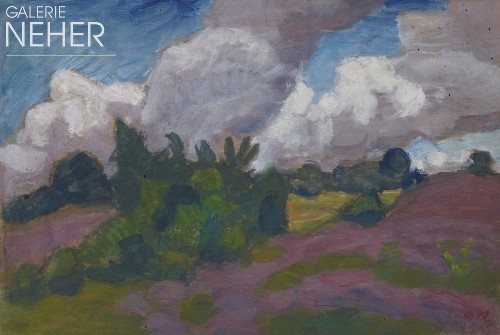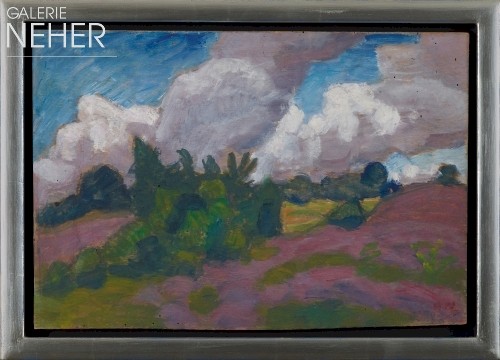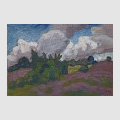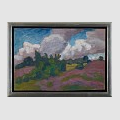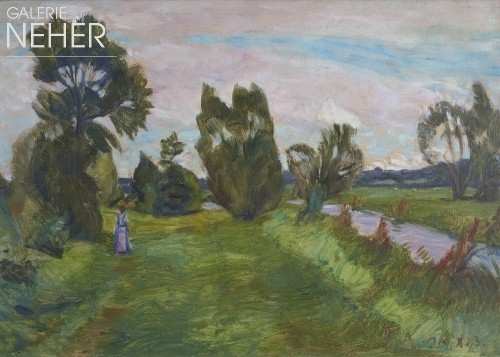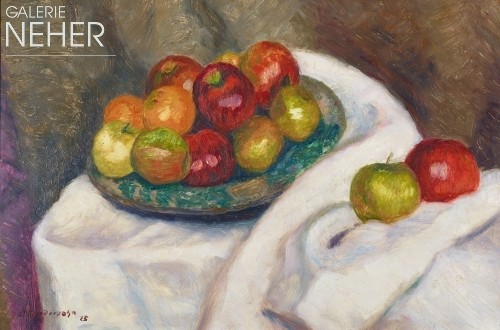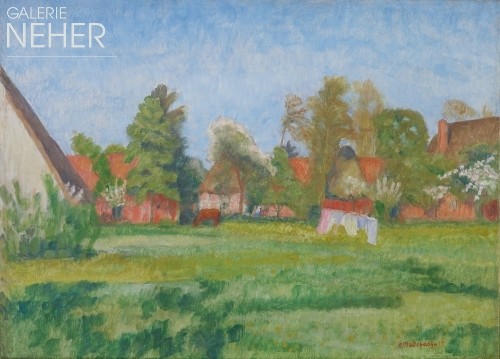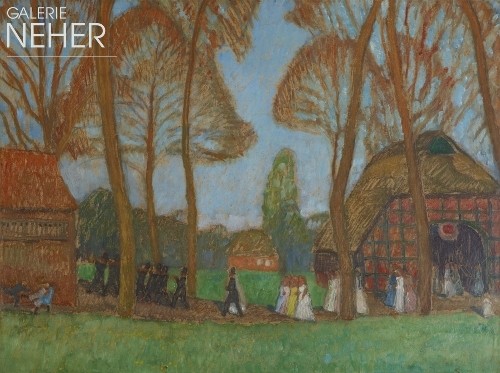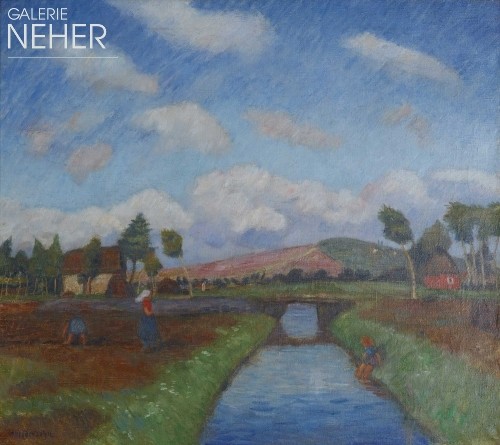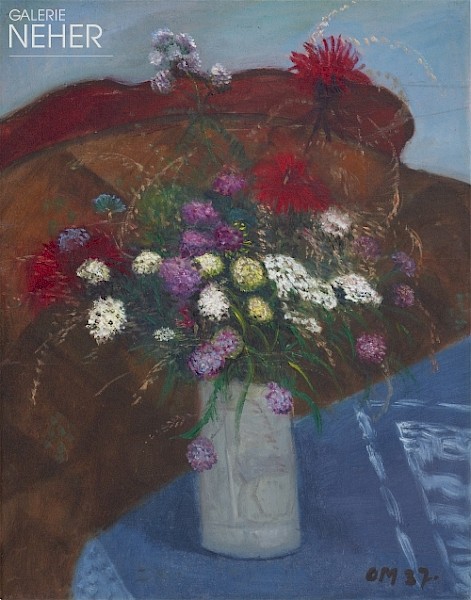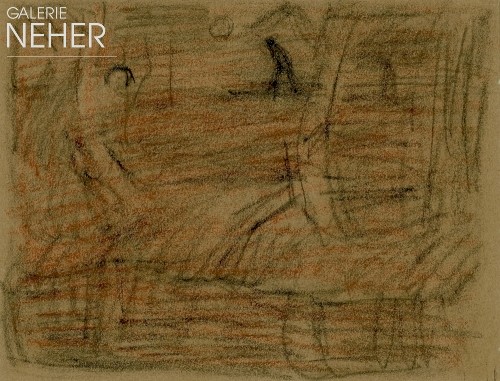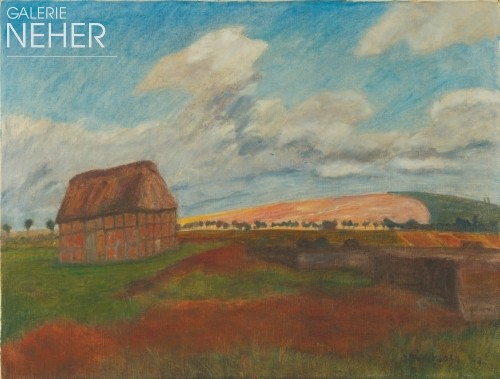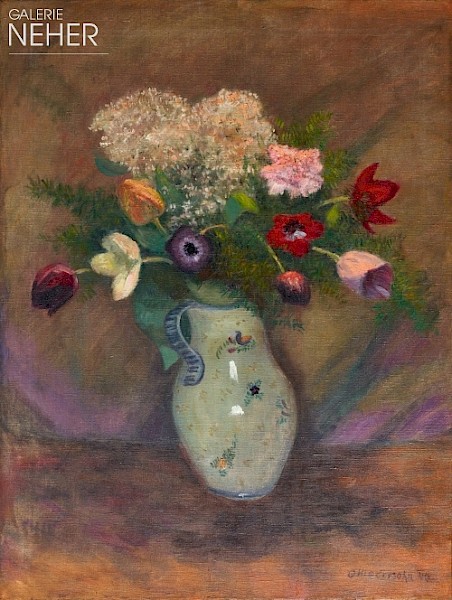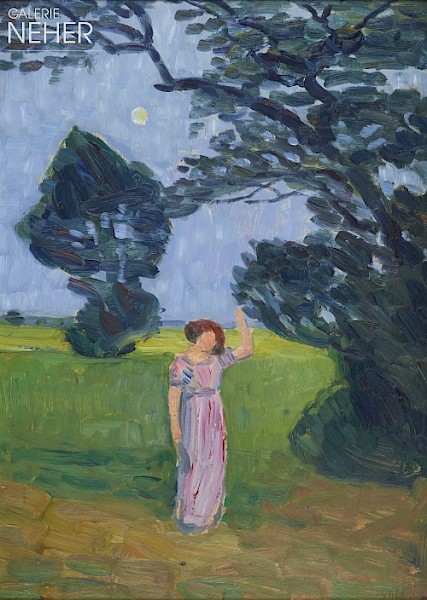Otto Modersohn - Sommerwolken über der Heide (Surheide) (Summer Clouds over the Heath), 1921
Tempera on hardboard
25 x 37 cm / framed 31 x 42 cm
9 x 14 inch / framed 12 x 16 inch
Signature and dating: monogrammed bottom right: OM, 1921
verso: handwritten title by Christian Modersohn
– with handmade craftman's frame –
N 9490
19,500 €
Expertise:
Otto Modersohn Museum, Fischerhude, Rainer Noeres 10.04.2022
Provenance:
Nachlass Otto Modersohn
Louise Mdersohn-Breling
Christian Modersohn
Antje Modersohn
Exhibitions:
Leeuwarden, Museum het Princessehof, Otto Modersohn, duits Landschapsschilder (1865--1943), 05.07. - 08.09 1985, Katalog mit farbiger Abbildung Seite 26
Essen, Galerie Neher, Herbst-Winter 2022/2023, Katalog mit farbiger Abbildung Seite 43
Otto Modersohn - Sommerwolken über der Heide (Surheide) (Summer Clouds over the Heath), 1921
Tempera on hardboard
25 x 37 cm / framed 31 x 42 cm
9 x 14 inch / framed 12 x 16 inch
Signature and dating: monogrammed bottom right: OM, 1921
verso: handwritten title by Christian Modersohn
– with handmade craftman's frame –
N 9490
19,500 €
Expertise:
Otto Modersohn Museum, Fischerhude, Rainer Noeres 10.04.2022
Provenance:
Nachlass Otto Modersohn
Louise Mdersohn-Breling
Christian Modersohn
Antje Modersohn
Exhibitions:
Leeuwarden, Museum het Princessehof, Otto Modersohn, duits Landschapsschilder (1865--1943), 05.07. - 08.09 1985, Katalog mit farbiger Abbildung Seite 26
Essen, Galerie Neher, Herbst-Winter 2022/2023, Katalog mit farbiger Abbildung Seite 43
About the work
The Surheide near Fischerhude was a motif often sought out by Otto Modersohn at the beginning of the 1920s. The at that time hardly wooded landscape was overgrown with individual bushes and a few groups of trees. Between these, sand, heath and pasture areas in the hilly grounds of the dune landscape formed a varied scenery.
Otto Modersohn changed from oil to tempera paint in 1921: “Tempera is wonderful - I can achieve anything with it - visible signature and dullness, thin, drippy, and then 5 minutes later the possibility to layer pastose. No other technique offers these advantages. And then the brilliance of the colours themselves. No paint, no oil paint, and no Weimar and Wurm paints has that. I dream of the most brilliant colour, the most delicate artistry, who has it? This hasn’t been strived for since Leibl. Mine is of course completely different. The lightness of the French: Renoir, Cézanne always stimulate me. Not Paula’s heaviness. That is the one entirely personal goal.
Otto Modersohn, Diary, 3 July 1921
Cumulus clouds tower to form mountains against a radiant blue summer sky over the landscape, which extends to the centre of the painting. The violet of the blooming heath contrasts with the green of the groups of trees. Breaking up the differentiated dichroism, a golden yellow field glows between them.
The natural forms are subjected to a summarising simplification. Modersohn dispenses without exception with graduating the painting with atmospheric perspective in this period. All pictorial objects seem equidistant. The paintings often have the flat character of a tapestry. The "pictorial mood”, especially characteristic of the late work, retreats almost completely as a result of a turning to the flat character, which is not atypical of the painterly tendency of Post-Expressionism.
Text authored and provided by Rainer Noeres, manager of the Otto Modersohn Museum in Fischerhude,
born 1948. Typesetter apprenticeship in Hamburg from 1965-1968. Study of fine arts at the Hochschule für bildende Künste in Hamburg (HfbK) from 1968-1973. Co-founder and operating partner of the Produzentengalerie Hamburg from 1973-2009. Teaching appointment for painting at the HfbK in 1974.
Married to Antje Modersohn, the daughter of Christian Modersohn, since 1976, three children. Decisively involved in establishing the Otto Modersohn Museum and archive in Fischerhude since 1977. Responsible for the creation of the catalogue raisonné of Otto Modersohn since 1980. Planning and execution of many exhibitions and cooperation projects with museums and art associations in Germany and abroad. Author of foundational publications on the work of Otto Modersohn. Employed since 2010 as head of the museum, as well as as voluntary managing director of the Otto-Modersohn-Gesellschaft e.V. and the Otto Modersohn Foundation, which were founded in 1989. Member of the board of the Otto Modersohn Foundation and of the Otto-Modersohn-Museum-Tecklenburg e.V. in Tecklenburg/Westphalia, founded in 2015. (Visit website)
